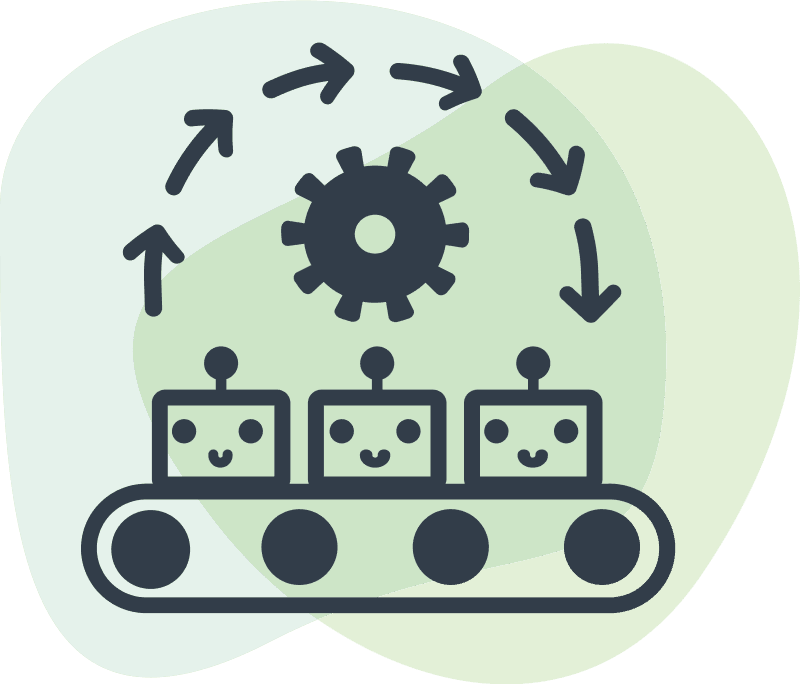Introduction
Navigating the intricate challenges of implementing a successful artificial intelligence (AI) strategy requires a comprehensive approach, where each interlocking strategic component plays a crucial role in overall success. Organizations need to coordinate all AI-relevant factors to ensure their AI strategy’s compatibility with long-term business objectives. This article presents the six most critical AI strategic factors, spanning data acquisition and problem definition to post-launch solution monitoring and ongoing maintenance, describing how organizations must deliberately consider each factor to ensure a sustainable AI strategy that addresses current and future business needs.
AI is a Tool Not a Solution
 Organizations often erroneously view implementing Artificial Intelligence (AI) as a goal that will automatically unlock new capabilities. They see it as a universal solution to complex business challenges and tough objectives and seek to acquire AI for AI’s sake.
Organizations often erroneously view implementing Artificial Intelligence (AI) as a goal that will automatically unlock new capabilities. They see it as a universal solution to complex business challenges and tough objectives and seek to acquire AI for AI’s sake.
But adopting AI technologies without a strategy wastes resources, diminishes problem-solving potential, and reduces trust in AI’s value. Instead, organizations must view AI as one powerful tool in a larger business solution toolset to achieve their most ambitious business goals as part of their strategic objectives.
AI is a means to an end, not an end goal itself. As an enabling technology, AI can efficiently automate tasks, uncover valuable insights, and augment human decision-making. Integrated effectively, it can enhance business functions like marketing, sales, operations, and HR. However, successfully applying AI requires linking it deliberately to specific business objectives.
To highlight the distinction, a goal is a desired, measurable outcome like revenue growth or improved customer satisfaction. The methods to achieve the goal are means to that end. For example, a customer relationship management (CRM) system could be an effective means to improve customer satisfaction. AI’s transformative potential often obscures the distinction between means and ends. Leaders sometimes assume adopting AI will automatically lead to success based on other industries without carefully considering how to apply it to their specific needs.
“Adopting AI technologies without strategy wastes resources, diminishes problem-solving potential & reduces trust in AI’s value.”
To harness AI fully and sustainably, organizations need to integrate it into their broader strategic vision. Identify key use cases where AI can provide tangible benefits, quantify the expected return on investment, and ensure implementation aligns with long-term business objectives.
AI holds considerable promise for organizations that deploy it thoughtfully. Viewing the acquisition of AI infrastructure as a solution risks misguided initiatives and wasted resources. Recognizing AI as a powerful tool that serves well-defined high-value goals allows organizations to unlock its transformative potential. In short, building AI capability is the beginning, not the end.
Elements of a Sustainable AI Strategy
Acquiring AI capabilities is important, but building a strong, sustainable AI strategy that provides consistent value requires a collaborative design. Every element of an AI strategy serves a specific purpose, and the strategy’s integrity relies on the quality and interplay of these individual elements. Below are six key components that should be carefully considered to create an AI strategy that aligns with your business objectives.
1. DATA INFRASTRUCTURE & GOVERNANCE
For AI strategies to work efficiently and yield meaningful results, a solid data framework and a well-defined data governance policy are crucial. Having a data-centric foundation not only fuels the creation of successful AI solutions but also ensures that the data feeding into these algorithms is reliable, secure, and compliant with relevant regulations.
A robust data infrastructure enables seamless data collection, storage, and processing. This serves as the backbone for any AI model, as the availability, quality, and quantity of data influences the model’s ability to solve a given business need reliably. Without a strong data infrastructure, organizations will face challenges in data ingestion, analysis, and solution repeatability leading to inaccurate predictions and erroneous insights. Given AI’s heavy dependency on data, making the investment in a dependable data infrastructure is a prerequisite for unlocking the full potential of AI technologies.
 Equally critical is data governance, which outlines the policies, procedures, and responsibilities concerning data quality, security, and privacy. Effective data governance ensures that the data used is consistent, trustworthy, and does not violate any applicable legal or ethical standards. With the increasing scrutiny on how data is used and stored, a strong governance framework not only mitigates risks but also enhances the credibility of AI initiatives.
Equally critical is data governance, which outlines the policies, procedures, and responsibilities concerning data quality, security, and privacy. Effective data governance ensures that the data used is consistent, trustworthy, and does not violate any applicable legal or ethical standards. With the increasing scrutiny on how data is used and stored, a strong governance framework not only mitigates risks but also enhances the credibility of AI initiatives.
The following are the main concerns that organizations should address when considering an adequate data infrastructure and data governance strategy for supporting AI:
- Data Quality – Ensuring accurate, consistent, and reliable data is paramount. Poor data quality can lead to flawed decisions. Procedures for cleaning, validating, and verifying data are imperative.
- Data Security – Protecting against unauthorized access and cyber threats is crucial. Breaches create financial and reputational damage. Encryption, multifactor authentication, and other protocols safeguard data.
- Compliance and Regulation – With regulations like the General Data Protection Regulation (GDPR) in Europe and the California Consumer Privacy Act (CCPA) in the United States, organizations are obligated to adhere to stringent data protection laws. Non-compliance risks severe penalties and legal issues.
- Data Access and Permissions – It is essential to clearly define who within an organization should have access to what data and under what circumstances. A well-established permissions system can prevent unauthorized data access and manipulation, thus maintaining data integrity and the AI solutions viability.
- Data Privacy – Ensuring the privacy of sensitive data, especially personal or financial information, is a significant concern. Organizations must have policies in place that dictate how this type of data is stored, used, and shared.
- Metadata Management – Understanding the context and origin of data is vital for effective data governance. Metadata management involves cataloging and defining data, making it easier for users and AI solution creators to find, use, and manage it.
- Data Lineage – Tracking the flow of data through its lifecycle—from its original source, through transformations, to its destination—helps in understanding and documenting how data is manipulated and calculated. This is crucial for understanding how to leverage the data when building AI solutions and identifying the downstream impact of upstream changes.
- Audit Trails – Maintaining a comprehensive record of data transactions and modifications is crucial for both compliance and troubleshooting purposes. Audit trails can help organizations pinpoint errors, unauthorized changes, or security breaches maintaining regulation compliance.
- Change Management – Data governance is not a one-time task but an ongoing process. Organizations need a robust change management framework to adapt to evolving business needs, regulatory changes, and technological advancements while also ensuring that upstream data changes are accommodated in downstream AI solutions.
Data infrastructure and governance are not mere supplements but core components of a sustainable AI strategy. They ensure that the AI models are built on a foundation of high-quality, reliable data, and that the resulting solutions operate within a framework of ethical and legal compliance. By prioritizing these elements, organizations can significantly improve the effectiveness and trustworthiness of their AI initiatives.
2. PROBLEM DEFINITION & FINANCIAL JUSTIFICATION
Starting an AI project without a clearly defined business problem is high risk. A comprehensive problem statement supported by quantitative metrics and financial justification provides critical direction and guidance. Assessing and projecting return on investment (ROI) offers transparency on expected economic impact. It also enables key performance indicators that provide measurable outcomes to evaluate AI effectiveness. Vague business objectives lead to misaligned AI projects unable to solve the intended problem or deliver ROI, eventually eroding trust in AI as a tool.
 Any pursuit of AI without sound financial rationale is imprudent. AI investments encompass infrastructure and human capital for effective implementation. Consequently, rigorous justification through expected ROI analysis is essential. ROI factors in both direct costs like development and operations along with indirect costs like integration disruptions. Financial justification provides stakeholder confidence that the AI application aligns with organizational goals and financial objectives, ensuring strategic coherence and stakeholder buy-in.
Any pursuit of AI without sound financial rationale is imprudent. AI investments encompass infrastructure and human capital for effective implementation. Consequently, rigorous justification through expected ROI analysis is essential. ROI factors in both direct costs like development and operations along with indirect costs like integration disruptions. Financial justification provides stakeholder confidence that the AI application aligns with organizational goals and financial objectives, ensuring strategic coherence and stakeholder buy-in.
In implementing AI solutions, a proven method is AI ROI daisy-chaining. Once a successful AI solution is deployed and shown to have a measurable impact on a high ROI project, the business approves the next AI project to operate within the financial benefits of the first. As AI-acquired ROI accumulates, the business can choose to take on more risk with subsequent AI projects, in effect only making the initial investment in AI and then reinvesting the AI-enabled benefits back into the AI strategy.
In summary, a precisely defined problem aligned to quantifiable business value provides the rationale for AI adoption and sustainable benefits. With this backbone, organizations can build focused, financially sound AI solutions that drive real business impact.
“Vague business objectives lead to misaligned AI projects unable to solve the intended problem or deliver ROI, eventually eroding trust in AI as a tool.”
3. CROSS-FUNCTIONAL TEAM DYNAMICS
For an AI application to be successful and align closely with organizational objectives, the involvement of a cross-functional team is pivotal. AI teams typically comprise experts from different organizational domains such as data science, IT, business strategy, and domain-specific roles relevant to the application. Planning complementary team composition ensures that the AI initiative is well-rounded and considers all relevant aspects of both the technology and business while researching and building the solution. This ensures not only a technically sound but also financially viable, operationally feasible, and strategically aligned solution. It minimizes the risk of tunnel vision, where the focus on one aspect overshadows other crucial elements.
With multi-department representation, the team has all the internal links to quickly identify and resolve challenges that might arise during AI application development. These may include data access issues, cost overruns, or misalignment with the specific business objective, reducing delays and minimizing unnecessary costs.
When stakeholders from multiple departments participate in implementing an AI application, they can communicate project details to their respective departments supporting better departmental communications, understanding and acceptance of the initiative across the organization.
“Judicious tool selection & infrastructure compatibility are key to unlocking the full potential of AI.”
4. AI TECHNOLOGY STACK
Selecting AI technologies and tools requires a nuanced approach rather than a one-size-fits-all decision. Organizations should choose a technology stack aligned to the project’s objectives, scalability needs, and team expertise. The technology stack choice is crucial for developing, deploying, and scaling AI solutions successfully. Programming languages, machine learning frameworks, and other associated tools each serve specific purposes within the AI solution life cycle with distinct pros and cons. Judicious tool selection and infrastructure compatibility are key to unlocking the full potential of AI.
When investigating an appropriate AI technology stack, consider the following:
- Required Skill Level – The tools must align with the developers’ and data scientists’ skillsets. Complex tools offer more functionality but may slow development if the team lacks sufficient expertise. Conversely, basic tools may not provide needed capabilities. The stack should balance functional needs with team proficiency.
- MLOps Integration – MLOps, or Machine Learning Operations, combines best practices from data science and IT operations to manage the AI lifecycle. Effective MLOps practices automate solution development and deployment, making AI development more efficient and sustainable. The stack should support MLOps automation for development, versioning and provenance, monitoring, and retraining to maximize solution ROI.
- Extendable AI Tools – Extendable, adaptable, scalable AI tools allows efficient modifications to existing machine learning models. These tools support modular architectures, compatibility with a range of algorithms, and support for various data formats and sources. This is key due to the rapid evolution of technology and business needs. Extendable tools enable seamless model updating without full redevelopment, saving resources.
 The technology stack fundamentally affects AI solution development and quality. Carefully considering team skills, integrating MLOps, and using extendable tools can improve AI initiative success, sustainability, and readiness for the future. The stack enables development velocity, model quality, and production-readiness. An optimal stack matches team capabilities, facilitates continuous ML lifecycle management, and provides adaptability for changing business needs. With a tailored, future-proof stack, organizations can build effective AI that delivers lasting value.
The technology stack fundamentally affects AI solution development and quality. Carefully considering team skills, integrating MLOps, and using extendable tools can improve AI initiative success, sustainability, and readiness for the future. The stack enables development velocity, model quality, and production-readiness. An optimal stack matches team capabilities, facilitates continuous ML lifecycle management, and provides adaptability for changing business needs. With a tailored, future-proof stack, organizations can build effective AI that delivers lasting value.
5. DEPLOYING AI SOLUTIONS
Successful deployment of AI solutions requires careful attention to implementation details to ensure development performance carries over into production environments. Key factors to consider include:
- Model Performance and Scalability – It is crucial to ensure a solution performs efficiently under fluctuating production loads. The infrastructure should be able to scale resources handle computational demand variation without compromising speed or accuracy.
- Data Coordination – AI solution performance depends on production data streams matching training data. Ensuring consistent data flows between training and production environments is vital. Any discrepancies between the two can significantly affect model effectiveness.
- Version Control and Rollback – Maintaining version control of models enables tracking changes and reverting to previous versions if needed. Rollback capabilities minimize disruption by allowing model reversion in case of errors or issues.
- Integration with Existing Systems – The AI model needs to interact seamlessly with existing software and data sources. Poor integration leads to inefficiencies, incorrect data flow, and other operational issues compromising solution performance.
Acknowledging and anticipating these factors when deploying AI solutions reduces encountered issues while maximizing solution efficiency and effectiveness solution so it can provide maximum ROI.
“AI solutions are not static; they require resources for ongoing management to sustain their effectiveness.”
6. POST-DEPLOYMENT MONITORING & MAINTENANCE
AI solutions are not static; they require resources for ongoing management to sustain their effectiveness. Post-deployment, the AI team should engage in continuous monitoring, performance metrics analysis, and regular updates. Feedback loops enable real-time adaptation, while routine maintenance and periodic recalibration update the solution to changing business landscapes.
To effectively support AI solutions in production, consider the following:
- Performance Metrics – Continuous evaluation of key performance indicators (KPIs) like accuracy, latency, and throughput are vital. Deterioration in such metrics indicates the need for immediate intervention.
- Model Decay – AI models become less accurate as the underlying data/business environment changes. Regular retraining of the model with fresh data is required to mitigate this.
- Resource Utilization – Resource allocation, such as CPU, memory, and storage, must be continuously monitored to ensure optimal performance. Spikes in resource usage can indicate a problem and may require re-architecting or optimization of the AI solution or associated services.
- Compliance and Auditing – Maintaining detailed logs and records is crucial for compliance with regulations such as GDPR or HIPAA. Tracking data handling and storage, model decisions, and any changes to the model or data.
- Cost Management – AI solutions require significant computational resources, and costs can quickly escalate. Regular reviews of expenditure against budget, and cost-benefit analysis, help ensure the solution remains financially viable.
- User Feedback – User feedback provides context for real-world performance and potential improvements that quantitative metrics may miss.
 Documentation and Version Control – Meticulously document changes, whether they are routine updates or emergency fixes. Version control systems, including Feature Stores, and Model Stores, can help create clear audit trail.
Documentation and Version Control – Meticulously document changes, whether they are routine updates or emergency fixes. Version control systems, including Feature Stores, and Model Stores, can help create clear audit trail.
Ongoing monitoring and maintenance are imperative to maximize the utility, performance, and longevity of AI solutions. Proactively addressing these concerns sustains reliability and drives success.
Conclusion
 In today’s rapidly evolving business landscape, the allure of artificial intelligence often leads organizations to view it as a panacea, rather than a tool integrated within a larger strategic business framework. It is becoming increasingly vital for businesses to use AI to achieve critical organizational objectives unattainable through other technical means. From the foundational aspects of data infrastructure and governance to the intricacies of implementation and ongoing management, a robust AI strategy requires a holistic and methodical approach. Well-planned AI strategies, rooted in sound data practices, cross-functional expertise, and aligned with long-term business objectives, can unlock transformative value for organizations. As the technological landscape continues to evolve, the ability to contextualize AI within the greater framework of organizational goals will be the distinguishing factor that enables companies to fully harness its promise and potential.
In today’s rapidly evolving business landscape, the allure of artificial intelligence often leads organizations to view it as a panacea, rather than a tool integrated within a larger strategic business framework. It is becoming increasingly vital for businesses to use AI to achieve critical organizational objectives unattainable through other technical means. From the foundational aspects of data infrastructure and governance to the intricacies of implementation and ongoing management, a robust AI strategy requires a holistic and methodical approach. Well-planned AI strategies, rooted in sound data practices, cross-functional expertise, and aligned with long-term business objectives, can unlock transformative value for organizations. As the technological landscape continues to evolve, the ability to contextualize AI within the greater framework of organizational goals will be the distinguishing factor that enables companies to fully harness its promise and potential.
How Ventera Can Help
As an established leader in the technology consulting space, Ventera offers an unparalleled end-to-end service portfolio that covers everything from data collection and storage to infrastructure and AI solutions.
“It is becoming increasingly vital for businesses to use AI to achieve critical organizational goals unattainable through other technical means.”
Leveraging over 25 years of IT expertise in both the commercial and government sectors, we possess the proficiency required to strategize, implement, or improve your data infrastructure, cloud management, and AI operations.
Contact us today to learn how our end-to-end technical expertise can help unlock your organization’s potential.



